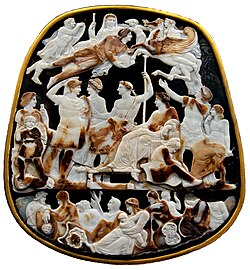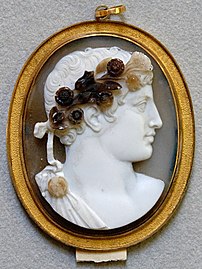cameo
Cameo ( the ), also Camée , rare Kameo ( the ) or Cameo , is the term for a as a raised relief of a gemstone , usually a chalcedony or Onyx but also from lava rock or mollusc shells prepared engraving , with (due to different tints color layers ) of the material, the raised part is usually lighter than the deeper part of the engraving.
In contrast to the cameo, with an intaglio or a gem, the motif is cut deeper into the stone. In comparison to gems, cameos often had a representative character. They were especially valued gemstones, which were hardly set in finger rings, but were used in various other jewelry (earrings, tiaras, neck and breast chains, etc.). They could also be used for box fittings and the decoration of living spaces, especially for those who were supposed to ward off disaster and the " evil eye " with the image of the Gorgon Medusa .
Cameos have been around since the 4th century BC. Known. They had a heyday in the Renaissance as well as in the 17th and 18th centuries. The manufacturing technique of the cameos comes from the Ptolemaic Alexandria (see: Tazza Farnese ). From there they conquered the Hellenistic and later also the Roman world, but never achieved the spread and popularity of the gems.
There are various traditions for the origin of the term, such as B. from the Persian chumahäu ; in medieval Latin one finds the word camahatus , in Italian chama , the shell, derived from the shell camées. In German-speaking used since the 14th century, various derivatives: GAMAH, gammaho, gämahü, gamähinstein, gamaphe, Camacha, camaie, camme, cammée - ultimately derived from them the word Gemme .
Antique Augustus cameo (Indian sardonyx ) as the central gem of the Lothar cross . Aachen, cathedral treasure
Gemma Augustea . Vienna Art History Museum
Allegory of Spring. Onyx cameo by Giuseppe Girometti . Paris, Cabinet des Médailles
literature
- Adolf Furtwängler : The ancient gems. 3 volumes. Giesecke & Devrient, Berlin 1900. Reprint: Hakkert, Amsterdam 1964–1965.
- Georg Lippold : gems and cameos of antiquity and modern times. Hoffmann, Stuttgart 1922.
- Fritz Eichler , Ernst Kris : The cameos in the art history museum. Schroll, Vienna 1927.
- Wolf-Rüdiger Megow: Cameos from Augustus to Alexander Severus. (= Ancient coins and cut stones. 11) de Gruyter, Berlin 1987, ISBN 3-11-010703-1 .
- Hugo Meyer : Ornamental cameos and state monuments of Roman art. New perspectives on the art of the early principals' days. Biering & Brinkmann, Munich 2000, ISBN 3-930609-21-5 .
- Günther Dembski: The ancient gems and cameos from Carnuntum. Phoibos, Vienna 2005, ISBN 3-901232-53-2 ( Carnuntum Archaeological Park Neue Forschungen 1).
- Erika Zwierlein-Diehl : Antique gems and their afterlife. de Gruyter, Berlin 2007, ISBN 978-3-11-019450-0 .
- Gertrud Platz-Horster (Ed.): Myth and Power. Sublime images in precious stone. International colloquium for the exhibition of the same name by the Antikensammlung Staatliche Museen zu Berlin in the Altes Museum am Lustgarten, July 27, 2007. Staatliche Museen, Berlin 2008, ISBN 978-3-88609-620-6 .
- Gertrud Platz-Horster: Sublime pictures. The cameos in the Antikensammlung Berlin. Reichert, Wiesbaden 2012, ISBN 978-3-89500-906-8 .
See also
- Daktyliothek (collection of gems, cameos and their prints)
Web links
- So-called. Gonzaga cameo (3rd century BC) in Fine Art Images - The Archive of Fine Arts







